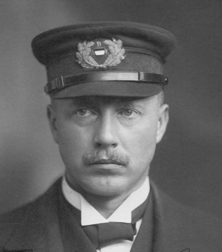Wilhelm Filchner (1877-1957)
 The story of Amundsen and Scott’s race to the pole has been told many times. Less well known is that of German explorer Wilhelm Filchner, who headed south in 1911 and also hoped to reach the South Pole. Filchner didn’t reach the Pole, but he did make two important geographic discoveries: the Filchner Ice Shelf and the Luitpold Coast and he disproved the existence of Morrell’s Land.
The story of Amundsen and Scott’s race to the pole has been told many times. Less well known is that of German explorer Wilhelm Filchner, who headed south in 1911 and also hoped to reach the South Pole. Filchner didn’t reach the Pole, but he did make two important geographic discoveries: the Filchner Ice Shelf and the Luitpold Coast and he disproved the existence of Morrell’s Land.
Filchner originally planned for one ship to enter the Weddell Sea while a second entered the Ross Sea. Land parties would then meet in the middle of the continent. The expedition was scaled back to one vessel however, due to lack of funding. The Deutschland set sail in May 1911 and, after a stop at South Georgia, departed for the Weddell Sea on Dec 11, 1911, just a few days before Amundsen reached the South Pole.
Filchner explored deep into the Weddell Sea where, on January 30, 1912, he spied the ice shelf that bears his name and the continent beyond. He named the region Prince Regent Luitpold Land (now known as the Luitpold Coast). An attempt to establish a winter camp met with disaster when the edge of the ice shelf broke apart and the nearly completed camp floated away on an iceberg. The ship then became stuck in the pack ice and they were forced to overwinter in the Weddell Sea. Filchner took advantage of this setback to lead a short, but dangerous, journey over the ice in search of ‘Morrell’s Land’ – thus making his third discovery – that the land spied by American sealer Benjamin Morrell in 1823 was nothing but a mirage. More about Filchner’s expedition